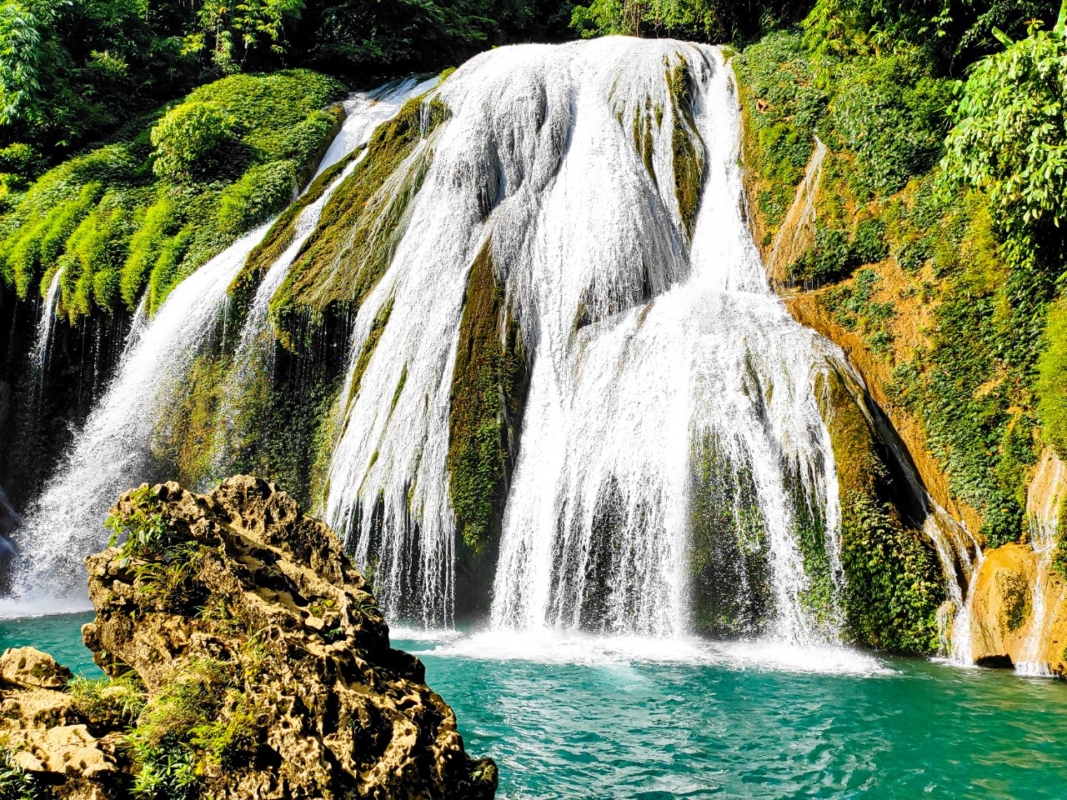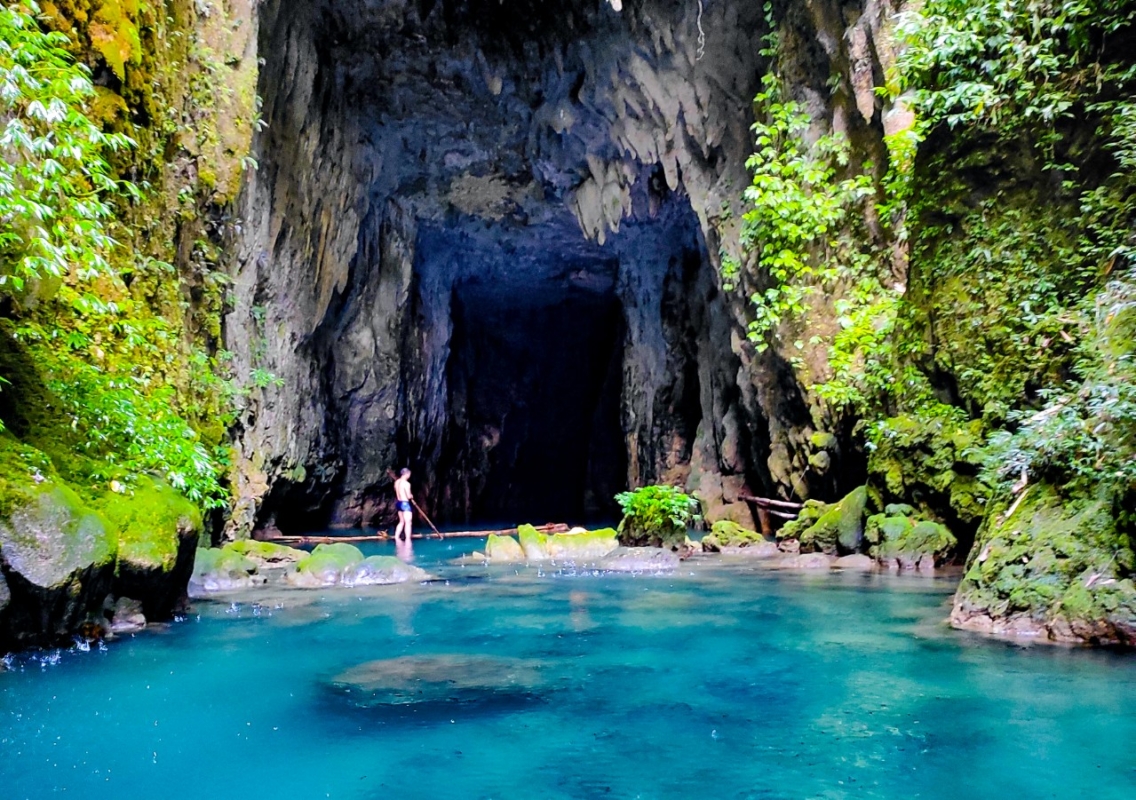Chympe Cave
Situated in the Khaddum village of Meghalaya’s East Jaintia Hills, Krem Chympe—India’s 5th longest cave—captivates travelers with its striking subterranean features and serene natural beauty—revealing an otherworldly karst landscape shaped by millennia of geological processes.
Entrance and Surroundings: The cave’s entrance is a dramatic spectacle, framed by towering limestone cliffs and lush vegetation. The area around the entrance features cascading silvery waterfalls that plunge into emerald pools, creating a captivating visual contrast with the dark, cavernous mouth of the cave.
River and Passageways: Inside Krem Chympe, the river flows horizontally, carving its path through the cave’s interior. The passageways are expansive, with the river disappearing into the cave’s depths. Exploration involves navigating these water-filled passages, often requiring swimming or using canoes and bamboo rafts.
It is possible to rappel down from a limestone overhang to reach Krem Chympe’s breathtaking lower entrance. The cave system extends further to an upper entrance near the village of Sielkan. The Meghalaya Adventurers’ Association mapped approximately 19 kilometers of this cave during the 2016 Abode of the Clouds Expedition.

Upon entering the cave, the gurgling sound of water echoes through the vast, dark passages. Canoeing through the pitch-black water channel for over three kilometers, explorers are met with a vast, deep lake created by a natural dam. Waterfalls cascade over intricate calcite formations, creating a dramatic and beautiful landscape. The cave’s ceiling arches high above, illuminated by headlamps.
At the first natural dam, or gour, inside the cave, the canoe must be hauled across the calcite formations to continue upstream.
Gours and Natural Dams: The cave is renowned for its stunning gours, or natural dams, formed by high concentrations of calcium carbonate in the cave water. These formations create towering banks and deep pools. Some gours reach up to 12 meters high and 8 meters deep, presenting an awe-inspiring sight. These natural dams, with their intricate calcite deposits, resemble bridges and other formations that have evolved over thousands of years.
Rock Formations: The cave’s walls are adorned with scallops—features hollowed out by the action of water. These scallops vary in size, reflecting the intensity of the water flow that shaped them. Larger scallops indicate slower water flow, while smaller ones suggest faster currents.
Stalactites and Stalagmites: In addition to the river passages, Krem Chympe includes relict passages where active waterways have ceased, revealing a world of stalactites and stalagmites. These formations create a surreal landscape of draped and rising mineral structures.
Ecosystem: The cave supports a fragile ecosystem with a variety of life forms. Bats, including leaf-nosed species, roost in the cave’s high reaches. The crystal-clear water houses diverse aquatic life, including Garra fish, shrimps, tadpoles, and crabs. The cave’s environment is also home to unique species like the glass shrimp and various cave-adapted spiders.
Underwater World: The cave’s underwater landscape is equally mesmerizing. Sunlight filtering through the cave’s entrance illuminates the submerged formations, creating a fantastical scene. The underwater world features limestone formations, illuminated by torchlight, with various aquatic creatures thriving in the cold, clear water.
Krem Chympe Cave stands as a testament to nature’s intricate artistry and the hidden wonders beneath the earth’s surface, offering an extraordinary blend of geological beauty and delicate ecosystems.

Khaddum Falls: An Unique Fan-shaped Waterfall
Pieltleng Waterfalls, located in Khaddum Village, is arguably the most stunning waterfall in Meghalaya and is considered the only known fan-shaped waterfall in the region. Commonly referred to as Chympe Falls or Khaddum Falls, this waterfall marks the starting point of the trek to the famous Krem Chympe cave.
The waterfall features calm, silvery streams that fan out gracefully over a lush, green rockface. The water cascades gently into a deep turquoise pool below, creating a mesmerizing contrast with the surrounding vibrant rainforest. The peaceful ambiance, combined with the unique fan-like formation of the waterfall, makes Pieltleng Waterfalls a breathtaking sight and a hidden gem in Meghalaya’s natural landscape.
Wah Luka River

In addition to the Chympe Cave and Pieltleng Waterfalls, the Wah Luka River flowing through Khaddum Village is another captivating attraction for tourists. Renowned for its unique and striking color, the Wah Luka River shifts from a vivid turquoise to a bright sky blue, a hue that can easily rival the famous Dawki River, a well-known tourist destination in Meghalaya.
The river’s stunning color is complemented by its serene surroundings, making it a perfect spot for nature lovers and adventurers alike. The riverbed serves as an ideal camping site, offering a tranquil setting where visitors can immerse themselves in the natural beauty of the area. The combination of the river’s vibrant color, the lush greenery, and the peaceful ambiance creates an unforgettable experience for those who venture to Khaddum Village.
How to Reach Khaddum Falls and Krem Chympe:
To reach Khaddum Falls and Krem Chympe, start from Lumshnong. Here’s the step-by-step guide:
- Shillong to Khaddum Village Distance: 124 Km (5 Hrs)
- Jowai to Khaddum Village Distance: 70 Km (2.30 Hrs)
- Khliehriāt to Khaddum Village Distance: 40 Km (1.30 Hrs)
1. From Shillong or Jowai to Lumshnong:
- By Road: Travel from Shillong or Jowai to Lumshnong, which is well-connected by road. Lumshnong is a key point on the way to Khaddum Falls and Krem Chympe.
2. From Lumshnong to Brichyrnot Village:
- By Vehicle: Drive towards Brichyrnot Village from Lumshnong. The village is about 7 km from the Lumshnong Toll Plaza.
- Navigation Tip: Use the dirt road on the left after crossing Lumshnong Toll Plaza, then keep right and follow the electric poles to reach Brichyrnot Village.
3. From Brichyrnot Village:
- Hire a Guide: Local guides are available in Brichyrnot for around ₹2000 per group. It’s advisable to hire a guide for navigation.
Travel Options:
- Trekking:
- To Khaddum Falls: Trek approximately 14 km from Brichyrnot Village to Khaddum Falls, crossing the Khaddum Hanging Foot Bridge.
- To Krem Chympe: From Khaddum Falls, trek 5 km through dense forest to reach Krem Chympe.
- Vehicle/Pickup Van (Dry Weather Option):
- To Khaddum Falls: In dry weather, you can hire a pickup van from Brichyrnot to a point closer to Khaddum Falls. This service costs around ₹1500 for a round trip. The walk from the parking area to the falls is about 2 km.
- To Krem Chympe: The trek from Khaddum Falls to Krem Chympe is about 5 km and passes through dense forest.
Additional Information:
- Facilities: No food or water facilities are available near the falls or the cave. Carry sufficient provisions and wear appropriate footwear for the trek.
- Safety: Ensure you are prepared for the trek and follow safety guidelines, especially when navigating the river and cave areas.
This guide provides a clear route from Lumshnong to Brichyrnot Village and onward to Khaddum Falls and Krem Chympe.


Can I get any guide’s number ?
Hi,
You have nicely explained journey of Krem chympe.
I am planning to reach Brichyrnot Village by bike. Is it easy to find a guide locally ? Do they provide trek + bamboo ride and cave explore with safety accessories with the mentioned guide charge for group Rs 2000
Hello,
Thank you for reaching out to us regarding your trip to Krem Chympe via Brichyrnot Village.
Yes, it is generally easy to find a local guide once you arrive at the village. The guides are well-acquainted with the route and usually provide a complete package that includes:
Trekking assistance
Bamboo raft ride
Cave exploration with safety equipment (life jackets, helmets, torches, etc.)
The guide charge of ₹2000 per group is the standard rate, covering all these activities. This ensures both safety and a hassle-free experience while exploring one of Meghalaya’s most fascinating caves.
We recommend starting early in the day, as the activity takes several hours and the route involves both hiking and water navigation.
Would you like us to pre-arrange a reliable guide for your group to save time when you reach Brichyrnot? If yes then please contact us.
Best regards,
Team SetMyTrip